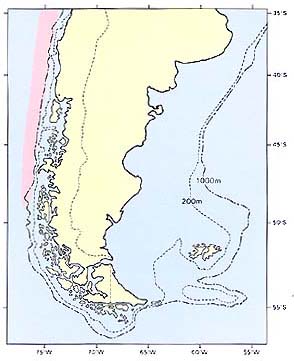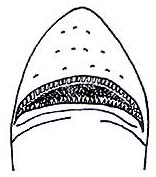ソコギス科
- HOME
- デジタル図鑑
- パタゴニア海域の重要水族
- 硬骨魚綱 ソコギス目 ソコギス科
ソコギス科(Notacanthidae)

2 ムツトゲソコギス(Mutsutoge-sokogisu)
Notacanthus sexspinis Richardson, 1846
Espinudo (Ch.)
特 徴:
背鰭7棘,1軟条,臀鰭14~15棘,115~130軟条,胸鰭11~14軟条,腹鰭1~3棘,6~8軟条,鰓耙数2~3+10~13=13~16。頭長は体長の13.1~14.6%,肉質眼窩は2.0~2.5%,体高は10.9~14.4%,吻長は3.4~4.0%,両眼間隔は2.5~3.6%,上顎長は2.6~3.6%,胸鰭長は6.3~7.3%,腹鰭長は4.5~5.8%,背鰭高(第1棘高)は0.8~1.3%,臀鰭高は3.3~4.5%。体は延長し,側扁し,ウナギ型を呈す。頭部は幅狭く,体長は頭長の6.8~7.6倍。眼は中庸でやや卵型を呈し,体長は眼径の5~6倍。吻は丸く,短く前方に突出し,頭長は吻長の3.6~4.0倍。両眼間隔域は著しく隆起する。眼の直前に両鼻孔が開き,両者は相接近し無鱗の皮膚で隔てられる。口は小さく下面に位置し突出不能,やや側扁した鋭い小歯が上顎に密に並ぶ。内側に湾曲した細長く小さな犬歯が下顎に1列に,口蓋骨に2列に並ぶ。下顎歯は口蓋骨歯とかみ合い,上顎歯とはかみ合わない。舌上に微小で軟らかい歯が散在する。擬鰓はない。鰓耙はよく発達する。鰓腔内は黒い。左右の鰓条膜は合して,峡部前半部をおおうのみ。小円鱗が体全体をおおう。背鰭は短くて硬いよく分離した7本の不動棘と1軟条からなる。背鰭起部は腹鰭の先端上に位置する。胸鰭は小さい。腹鰭第1棘は非常に小さく痕跡的。臀鰭棘は短くて不動。臀鰭軟条は棘より長く後方で尾鰭と連続する。臀鰭起部は背鰭第3棘下に位置する。尾鰭は伸長して終る。側線は1本で,主鰓蓋骨上縁上に発し第40~45臀鰭棘の上方あたりまで達する。主鰓蓋骨後縁は黒い。体は黒褐色で,各鰭は黒っぽい。
分 布:
チリ パタゴニアに分布する。南アフリカ,ニュージーランドおよびオーストラリアからも知られている(McDowell, 1973)。
備 考:
第72あけぼの丸の調査では水深400m付近で漁獲された。
(中村 泉)
Material examined:
7 from Chile (385.5-590.0 mm SL), FAKU CP 34, 220, 342, 343, 648, 705, 856.
Description:
D Ⅶ, 1; A ⅩⅣ-ⅩⅤ, 115-130; P1 11-14;P2Ⅰ-Ⅲ, 6-8; GR 2-3+10-13=13-16. HL 13.1-14.6% of SL; FO; 2.0-2.5; BD 10.9-14.4; SN 3.4-4.0; IO 2.5-3.6; UJ 2.6-3.6; P1L 6.3-7.3; P2L 4.5-5.8; DH (last spine) 0.8-1.3; AH1 3.3-4.5.
Bady elongate, compressed and eel-like. Head narrow, 6.8-7.6 in SL. Eye moderate, oval, its diameter about 5-6 in HL. Snout round and short, well projecting beyond mouth, its length 3.6-4.0 in HL. Interorbial region strongly convex. Two nostrils just in front of eye, close each other, separated by smooth and scaleless skin. Mouth small, inferior and nonprotractile. Single row of compressed and sharp teeth densely arranged on upper jaw. Fine and long canine teeth curving inward, one row on lower jaw and two rows on palatine. Teeth on palatine and lower jaw occlude. Fine and soft teeth scattering on tongue. No pseudobranchiae. Gill-rakers well developed. Gill-cavity black. Both left and right branchiostegal membranes united, covering anterior part of isthmus. Small cycloid scales covering whole body. Dorsal fin with 7 very short, stiff and immovable spines, followed by one short soft ray, its origin above tip of pelvic fin. Pelvic fin with 1 to 3 spines, first spine rudimentary. Anal fin spines very low and immovable and soft rays higher, uniting to caudal fin, its origin below 3rd dorsal spine. Single lateral line running from upper insertion of opercle to above 40-45th soft ray of anal fin. Body dark brown with darker fins. Posterior margin of opercle tinged with black.
Distribution:
Chilean Patagonia, also known from South Africa, New Zealand and Australia.
Remarks:
An Indo-Pacific deep water species, found from the Cape to Natal in 200-600 fathoms around South Africa (Smith, 1977).
(Izumi NAKAMURA)

Distribution of Notacanthus sexspinis in Patagonia.

Ventral view of mouth.
- 1
- 2